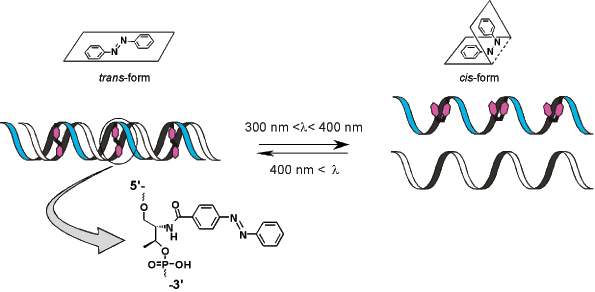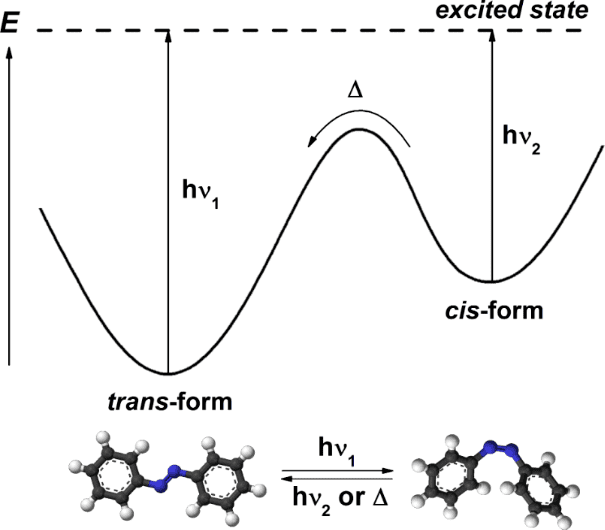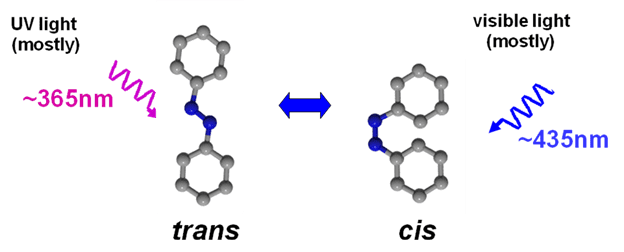Related compounds Melting point 69 °C Boiling point 293 °C | Formula C12H10N2 Density 1.09 g/cm³ Appearance orange-red crystals | |
Azobenzene dyes great application of quantum organic and bonding
Azobenzene is a chemical compound composed of two phenyl rings linked by a N=N double bond. It is the simplest example of an aryl azo compound. The term 'azobenzene' or simply 'azo' is often used to refer to a wide class of molecules that share the core azobenzene structure, with different chemical functional groups extending from the phenyl rings. These azo compounds are considered as derivatives of diazene (diimide), and are sometimes referred to as 'diazenes'. The diazenes absorb light strongly and are used as dyes in a variety of industries.
Contents
- Azobenzene dyes great application of quantum organic and bonding
- Synthesis of azobenzene
- Synthesis
- Trans cis isomerization
- Spectroscopic classification
- Photophysics of isomerization
- Photoinduced motions
- Other aspects
- References

Synthesis of azobenzene
Synthesis

Azobenzene was first described by Eilhard Mitscherlich in 1834. Azobenzene was investigated in 1856 by Alfred Nobel as "gelblich-rote krystallinische Blättchen" ("yellowish-red crystalline flakes" in German). Its original preparation is similar to the modern one. According to the 1858 method, nitrobenzene is reduced by iron filings in the presence of acetic acid. In the modern synthesis, zinc is the reductant in the presence of a base.
Trans-cis isomerization

One of the most intriguing properties of azobenzene (and derivatives) is the photoisomerization of trans and cis isomers. The two isomers can be switched with particular wavelengths of light: ultraviolet light, which corresponds to the energy gap of the π-π* (S2 state) transition, for trans-to-cis conversion, and blue light, which is equivalent to that of the n-π* (S1 state) transition, for cis-to-trans isomerization. For a variety of reasons, the cis isomer is less stable than the trans (for instance, it has a distorted configuration and is less delocalized than the trans configuration). The trans isomer is more stable by approximately 50 kJ/mol, and the barrier to isomerization in the ground state is approximately 100 kJ/mol.

Thus, cis-azobenzene may thermally relax back, in dark, to the trans isomer. Such thermal relaxation is slow at room temperature, and competes with photogeneration of the cis-isomer if the compound is exposed to ultraviolet or visible light.
Spectroscopic classification

The wavelengths at which azobenzene isomerization occurs depends on the particular structure of each azo molecule, but they are typically grouped into three classes: the azobenzene-type molecules, the aminoazobenzenes, and the pseudo-stilbenes. These azos are yellow, orange, and red, respectively, owing to the subtle differences in their electronic absorption spectra. The compounds similar to the unsubstituted azobenzene exhibit a low-intensity n-π* absorption in the visible region, and a much higher intensity π-π* absorption in the ultraviolet. Azos that are ortho- or para-substituted with electron-donating groups (such as aminos), are classified as aminoazobenzenes, and tend to closely spaced n-π* and π-π* bands in the visible. The pseudo-stilbene class is characterized by substituting the 4 and 4' positions of the two azo rings with electron-donating and electron-withdrawing groups (that is, the two opposite ends of the aromatic system are functionalized). The addition of this push-pull configuration results in a strongly asymmetric electron distribution, which modifies a host of optical properties. In particular, it shifts the absorption spectra of the trans and the cis isomers, so that they effectively overlap. Thus, for these compounds a single wavelength of light in the visible region will induce both the forward and reverse isomerization. Under illumination, these molecules cycle between the two isomeric states.
Photophysics of isomerization
The photo-isomerization of azobenzene is extremely rapid, occurring on picosecond timescales. The rate of the thermal back-relaxation varies greatly depending on the compound: usually hours for azobenzene-type molecules, minutes for aminoazobenzenes, and seconds for the pseudo-stilbenes.
The mechanism of isomerization has been the subject of some debate, with two pathways identified as viable: a rotation about the N-N bond, with disruption of the double bond, or via an inversion, with a semi-linear and hybridized transition state. It has been suggested that the trans-to-cis conversion occurs via rotation into the S2 state, whereas inversion gives rise to the cis-to-trans conversion. It is still under discussion which excited state plays a direct role in the series of the photoisomerization behavior. However, the latest research on femtosecond transition spectroscopy has suggested that the S2 state undergoes internal conversion to the S1 state, and then the trans-to-cis isomerization proceeds. Recently another isomerization pathway has been proposed by Diau, the "concerted inversion" pathway in which both CNN bond angles bend at the same time.
Photoinduced motions
The photo-isomerization of azobenzene is a form of light-induced molecular motion. This isomerization can also lead to motion on larger length scales. For instance, polarized light will cause the molecules to isomerize and relax in random positions. However, those relaxed (trans) molecules that fall perpendicular to the incoming light polarization will no longer be able to absorb, and will remain fixed. Thus, there is a statistical enrichment of chromophores perpendicular to polarized light (orientational hole burning). Polarized irradiation will make an azo-material anisotropic and therefore optically birefringent and dichroic. This photo-orientation can also be used to orient other materials (especially in liquid crystal systems). For instance, it has been used to orient liquid crystal domains selectively, and to create nonlinear optical (NLO) materials. Azo isomerization can also be used to photo-switch the liquid crystal phase of a material from cholesteric to nematic or to change the pitch of a cholesteric phase.
In 1995, it was reported that exposing a thin film of azo-polymer to a light intensity (or polarization) gradient leads to spontaneous surface patterns. In essence, the polymer material will reversibly deform so as to minimize the amount of material exposed to the light. This phenomenon is not laser ablation, since it readily occurs at low power and the transformation is reversible. The mechanism of this surface holography seems related to a new photomechanical effect, involving azobenzene isomerization.
Bulk expansion and contraction of azobenzene materials have also been observed. In one report, a thin film was made to bend and unbend by exposing it to polarized light. The direction of the macroscopic motion could be controlled by the polarization direction. The bending occurred because the free surface of the material contracted more than the inside of the thin film (due to absorption of laser light as it passes through the film).
Other aspects
Azobenzene molecules can be incorporated into polymer matrices as stabilizers. It is also interesting to note that the rigid rod-like structure of azo molecules allows them to behave as liquid-crystal mesogens in many materials.
The large geometry change associated with azobenzene photoisomerization has also been used to control protein activity with light. Azobenzene has been attached to ligands (drug) to photo-modulate their affinity for proteins. Azobenzene has been employed as a photoswitchable tether between a ligand and the protein: one end of the azobenzene is substituted with a reactive group that attaches to the target protein. The other end displays a ligand for the protein. Depending on where the azobenzene is attached, either the cis or trans isomer will present the ligand to the ligand-binding site, while the other isomer prevents the drug from reaching the site. Again, photoswitching between isomers turns the protein on and off. When applied to ion channels in the nervous system, this approach affords optical control of electrical activity in neurons.
